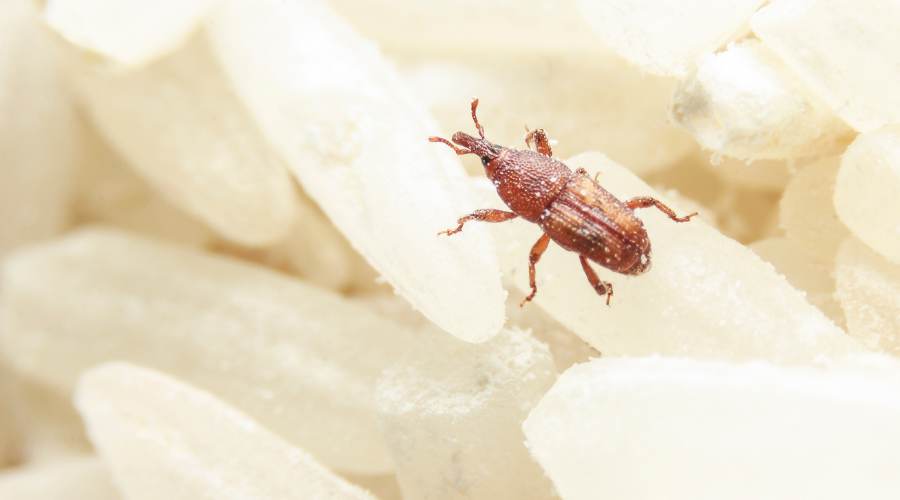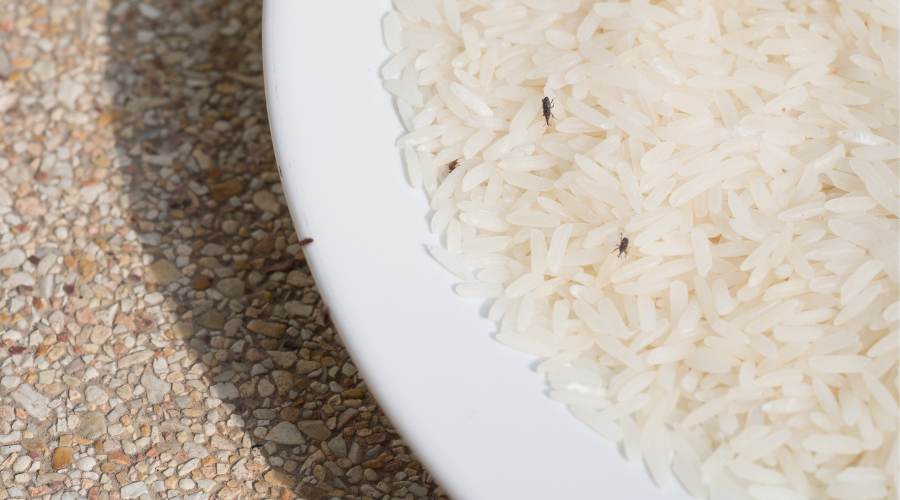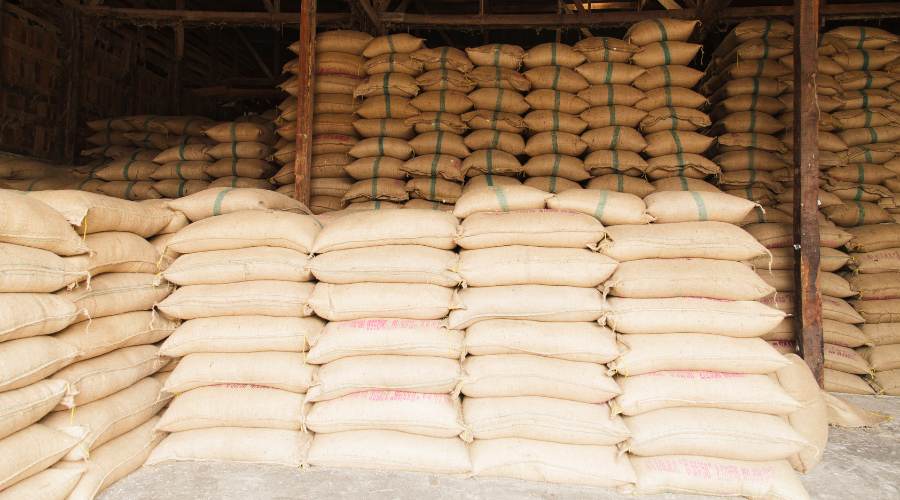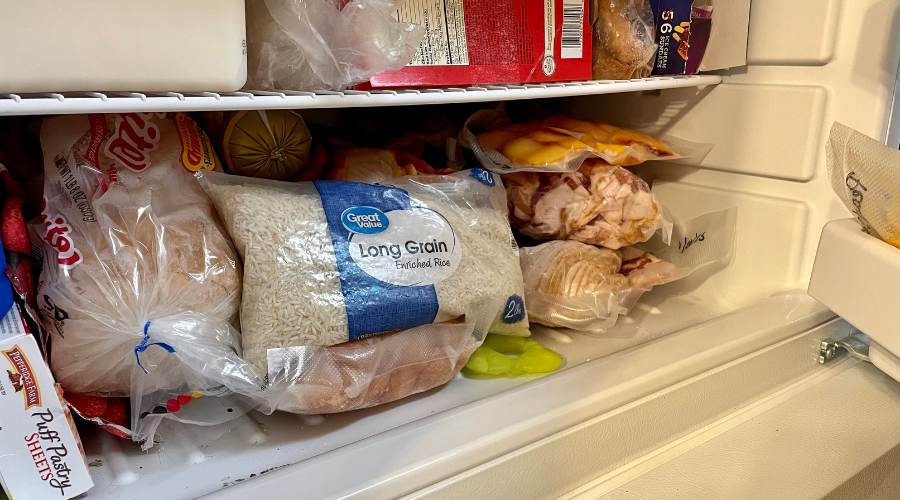Rice is a staple food that is enjoyed by many around the world. When I was young, I recall finding little bugs in a rice bag and being disgusted. Come to find out they were rice weevils that can infest your stored grains. These pesky insects not only ruin your rice but also can cause health issues. As I think back I can’t help but investigate the question, how do you get rid of bugs in rice?
To get rid of rice bugs, it’s important to understand the life cycle of the specific type of bug, such as rice weevils, and use natural methods of control like neem oil, diatomaceous earth, or essential oils. Additionally, cleaning and storing rice properly (see detailed how to storage guide), such as using airtight containers, freezing, or drying can prevent infestation, and it’s important to know when it’s safe to consume infested food.
Worry no more, in this article, we will dive deep into the world of rice weevils (the same as other grain weevils), their life cycle, and how to prevent and eliminate them naturally. We’ll also cover how to clean and store rice to avoid infestation and the safety concerns of consuming infested food. By the end of this article, you will have all the knowledge and tools you need to keep your rice bug-free.
Identifying Weevil or Bugs in Rice
Identifying weevils or bugs in rice can be done by visually inspecting the rice (it can be helpful to look up weevil photos). Rice weevils are small, reddish-brown beetles that are about 1/8 inch long. They have a distinct snout-like protrusion on the head and a pair of small, curved antennae. They can be found crawling on the surface of the rice or hiding inside the grains.

Another way to identify weevils in rice is to look for small, round holes in the rice grains. These holes are caused by the weevils eating their way through the rice. In addition, you may also find small, reddish-brown, or black rice weevil eggs that are laid on the surface of the rice. They look like small, round specks.
You can also find the presence of bugs in rice by noticing the rice has an off smell, or if the rice is clumped together and feels moist, this can indicate the presence of insects.
If you suspect that you have weevils or bugs in your rice, it’s important to take action as soon as possible to prevent further infestation.
Should I Throw Away Rice that has Weevils or Bugs in it?
If you find weevils in your stored rice, it can be difficult to know what to do with it. On one hand, it’s a waste to throw away a perfectly good food item, but on the other hand, you don’t want to risk eating something that could be contaminated with bugs. So, what should you do?
Is it Safe to Eat Rice or Other Dry Foods with Weevil?
First, it’s important to understand that weevils are not harmful to humans and do not cause any health issues so it is technically safe to eat rice and other dry foods that have weevils in them (see sfa.gov). They do not carry any diseases or pathogens, so if you accidentally ingest a few, it’s not a big deal. However, the presence of weevils in your food can be unsightly and unappetizing.

When deciding whether to throw away rice with weevils, there are a few factors to consider:
- Age of the rice: Weevils are more likely to infest older rice that has been stored for a long time. If the rice is relatively new and you just purchased it, it might be worth trying to salvage it. See the shelf life of 14 commonly used rice.
- The extent of infestation: If you notice a small number of weevils in your rice, it might be worth trying to salvage it by removing the bugs. However, if the infestation is extensive, it might be best to throw the rice away.
- Personal preference: Ultimately, the decision of whether or not to throw away rice with weevils is a personal one. If the thought of eating rice with bugs in it makes you uncomfortable, it might be best to throw it away and replace it.
If you choose to throw away the rice, it’s important to properly dispose of it. Weevils can lay eggs in the rice, which will hatch into larvae and continue the infestation. To prevent this, seal the rice in a plastic bag and throw it away in an outdoor trash can.
In summary, while it may not be harmful to consume rice with weevils, it’s not always the most pleasant experience. So, decide whether to keep or throw away rice with weevils based on age, the extent of the infestation, and your personal preference.
Do rice weevils lay eggs (Weevil Larvae) in rice?
Yes, rice weevils do lay eggs in rice. Female weevils will lay their eggs on the surface of the rice grains. The eggs are small, round, and white in color, about the size of a pinhead. They will hatch into larvae (weevil larvae) in about 4-5 days. These larvae are small, white, and legless. They will burrow into the rice grains and begin to feed.
They will then go through several stages of growth before pupating and emerging as adult weevils. It’s important to take preventive measures as soon as possible to prevent the infestation from becoming worse as the rice weevils will lay eggs on rice and rice flour, which will increase the infestation.
How do bugs get in a sealed bag of rice?
Bugs can get into a sealed bag of rice in a number of ways. The most common way is through the manufacturing process. Rice weevils can be present in the rice fields, and if not properly cleaned and processed, they can end up in the final product. They can also be present in storage and transportation facilities and can be introduced to sealed bags of rice during these stages.

Another way bugs can get into sealed bags of rice is through small holes or tears in the packaging. These can be caused by a variety of factors, such as improper handling during transportation or storage, or damage during the packaging process.
Additionally, if you already have an infestation in your pantry or kitchen and you bring a sealed bag of rice, it may not be completely sealed, or the packaging may have small holes that allow the bugs to get in.
It’s also important to note that Rice Weevils can remain in the dormant stage for a long time, so if the rice was stored in an infested area, it could have eggs, pupae, or adults that will hatch and infest the rice once again.
How to Get Rid of Rice Weevil or Bugs Naturally (Pest Control)
There are several effective ways to naturally prevent weevils or bugs from infesting rice. The following are some of the best methods to try:
- Freezing
- Sunlight
- Herbs
- Diatomaceous Earth
- Sticky Traps
Freeze Rice Before Putting it in Food Storage
Freezing is an effective way to kill rice weevils or bugs naturally before storing it. Here is a step-by-step guide on how to do it:
- Inspect the Rice: Before freezing, inspect the rice carefully to make sure it is not infested with weevils or bugs. Discard any rice that appears to be infested.
- Clean the Rice: Clean the rice by rinsing it thoroughly under running water. This will help to remove any dirt or debris that may be on the rice.
- Dry the Rice: Spread the rice out on a clean surface and allow it to dry completely. This will help to prevent any moisture from being trapped in the rice when it is frozen, which can lead to freezer burn.
- Place in a Plastic Bag: Once the rice is dry, place it in a sealable plastic bag. Be sure to remove as much air as possible from the bag to prevent freezer burn.
- Place in the Freezer: Place the bag of rice in the freezer and leave it there for at least 48 hours. This will ensure that any adult weevils, larvae, or eggs that may be present will be killed by the cold temperatures.
- Remove from the Freezer: After 48 hours, remove the bag of rice from the freezer and let it thaw at room temperature. Once the rice has thawed, it can be stored in airtight containers or resealable plastic bags to prevent future infestations.

It’s important to consider that freezing should kill the adult weevils, larvae, or eggs that may be present but it won’t prevent future infestations. It’s important to take preventive measures, such as keeping your rice storage area clean, using airtight containers, keeping the rice dry, and inspecting rice and other dry food products before storing them to ensure they are not infested.
Use Direct Sunlight to Kill Insects
Sunlight can be used as an effective way to get rid of weevils or bugs from rice naturally. The high temperatures and UV rays from the sun can kill the weevils or bugs, as well as their eggs and larvae. Here are three simple steps to use sunlight to get rid of weevils or bugs from rice naturally:
- Clean the rice by rinsing it thoroughly under running water, then spread it out on a clean surface in a sunny spot.
- Leave the rice exposed to direct sunlight for at least 4 hours. The UV rays and high temperatures of the sun will help to kill any weevils or bugs that may be present in the rice.
- Store the rice in an airtight container or resealable plastic bag once it is free of weevils or bugs to prevent future infestations.
Use Herbs
It is effective to use certain herbs to repel insects from your rice storage. Fortunately, these herbs are natural and can be stored right in your rice without compromising it.
Do bay leaves keep bugs out of rice?
Bay leaves are known to have insect-repelling properties and are often used in natural pest control methods. They contain compounds like eucalyptol and cineole which give off a strong aroma that bugs and insects find unappealing. Adding a few bay leaves to a container or bag of rice can help to keep bugs like weevils out.

What Herbs and How to Use them?
Three herbs that are known for their insect-repelling properties include:
- Bay leaves
- Cloves
- Thyme
To take advantage of this natural method of repelling weevil, place one of the three herbs in your rice storage container or bag. will help to repel any weevils or bugs that may be present, as well as prevent any future infestations. Store the rice in an airtight container or resealable plastic bag once it is free of weevils or bugs to prevent future infestations.
Use Diatomaceous Earth
Diatomaceous earth (DE) is a naturally occurring, soft, sedimentary rock that is made up of the fossilized remains of tiny aquatic organisms called diatoms. It is a fine powder that is safe to use around food and is often used as a natural pest control method. DE works by absorbing the oils and fats from the exoskeleton of insects, causing them to dehydrate and die.
Here are three simple steps to use DE to get rid of weevils or bugs from rice:
- Clean the rice by rinsing it thoroughly under running water, then spread it out on a clean surface.
- Sprinkle a thin layer of DE on top of the rice, making sure to cover all surfaces.
- Gently mix the DE into the rice, being careful not to inhale the powder as it can be harmful to the lungs if inhaled in large quantities.
DE is an effective way to prevent future infestations but may not kill all weevil, larvae, or eggs that may already be infesting your rice. Therefore, it is important to make sure you clean the rice well and don’t see any signs of current infestation before cooking with or eating it.
Does washing rice remove bugs?
Washing rice can help to remove any visible bugs or debris that may be present on the surface of the rice. However, it is important to note that washing rice will not necessarily remove all bugs or weevil eggs that may be present within the rice. This is because the eggs and larvae are often hidden deep within the rice kernels, making them difficult to detect and remove.
Washing rice before cooking is a good practice to get rid of dirt, dust, and other impurities that may be present on the surface of the rice. However, it is important to also take other preventive measures such as inspecting rice, freezing it, and using natural pest control methods such as bay leaves or diatomaceous earth before storing it to ensure it is not infested.
How do you keep bugs out of uncooked rice (Prevent Weevils)?
Keeping bugs out of uncooked rice can be a challenge, but there are several effective methods that you can use to prevent infestations. Here are a few tips to help you keep your rice bug-free:
- Buy rice in small quantities or break up bulk amounts into smaller portions: Properly package smaller portions of stored rice so that it is easy to pull out and use only the amount that you need. This will help to prevent infestations from occurring in your stored rice.
- Store rice properly: Keep rice in airtight containers that are made of hard plastic, glass, or mylar bags and sealed food-grade buckets. This will keep bugs out and will also help to protect the rice from moisture. See a full guide on how to store rice long-term.
- Keep your storage area clean: Regularly clean your rice storage area to remove any food crumbs or debris that could attract bugs.
- Keep your rice dry: Bugs thrive in moist environments, so it’s important to store your rice in a dry place. Keep the rice away from damp or humid areas, and consider using a moisture absorber such as silica gel packets to help keep the rice dry.
- Use natural pest control methods: Using natural pest control methods such as bay leaves, diatomaceous earth, or freezing rice before storing can help to keep bugs out of your rice.
- Inspect rice before storing: Before storing rice, inspect it carefully for bugs or eggs. If you find any, discard the infested rice and take steps to clean and sanitize your storage area.
By following these tips, you can help to keep bugs out of your uncooked rice and ensure that your rice stays fresh and bug-free.
In conclusion, dealing with bugs in rice can be a frustrating experience, but it is possible to get rid of them naturally. Identifying the bugs, freezing rice before storing, using sunlight, herbs, or Diatomaceous Earth, washing rice, keeping the storage area clean, using natural pest control methods, inspecting rice before storing and buying rice in small quantities are all effective ways to prevent infestations and keep your rice bug-free. With a little bit of effort, you can enjoy your rice without any unwanted bug visitors.



